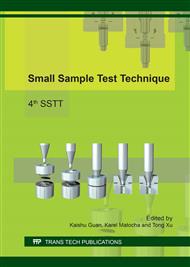[1]
P. Visweswaran, Anand Bhushan, V. Karthik, D. Pawaskar, T. Jayakumar, K.V. Kasiviswanathan, Baldev Raj, Tensile properties from ball indentation by numerical methods and experiments, Proceedings of the 2nd International Conference on small punch tests and other miniature technology, Ostrava, Czech, (2012).
Google Scholar
[2]
Sneddon I.N., The relation between load and penetration in the axisymmetric boussinesq problem for a punch of arbitrary profile, Int. J. Eng. Sci. 3 (1965) 47-57.
DOI: 10.1016/0020-7225(65)90019-4
Google Scholar
[3]
Hill R., Storakers B., Zdunek A.B., A theoretical study of the Brinell hardness test, Proc. R. Soc. London. A423 (1989) 301-330.
Google Scholar
[4]
Jeong-Hoon Ahn and Dongil Kwon, Derivation of plastic stress-strain relationship from ball indentation: Examination of strain definition and pileup effect, J. Mater. Res. 11 (2001) 3170-3178.
DOI: 10.1557/jmr.2001.0437
Google Scholar
[5]
Oliver W. C. and Pharr G. M., An improved technique for determining hardness and elastic modulus using load and displacement sensing indentation experiments, J. Mater. Res. 7 (1992) 1564-1583.
DOI: 10.1557/jmr.1992.1564
Google Scholar
[6]
NEN, NEN-EN-ISO 14577, Metallic materials – Instrumented indentation test for hardness and materials parameters - Part 4: Test method for metallic and non-metallic coatings (ISO 14577-4: 2007).
DOI: 10.3403/30091639u
Google Scholar
[7]
Tabor D., Hardness of Metals. Clarendon Press, Oxford, (1951).
Google Scholar
[8]
Hainsworth S.V., McGurk M.R. and Page T.F., The effect of coating cracking on the indentation response of thin hard-coated systems, Surface and Coatings Technology 102 (1998) 97-107.
DOI: 10.1016/s0257-8972(97)00683-x
Google Scholar
[9]
Zhou X. Y., Jiang Z. D. and Wang H. R., Study on the calibration methods of machine compliance for depth-sensing indentation instrument, Chinese Journal of Scientific Instrument 28 (2007) 85-89.
Google Scholar


